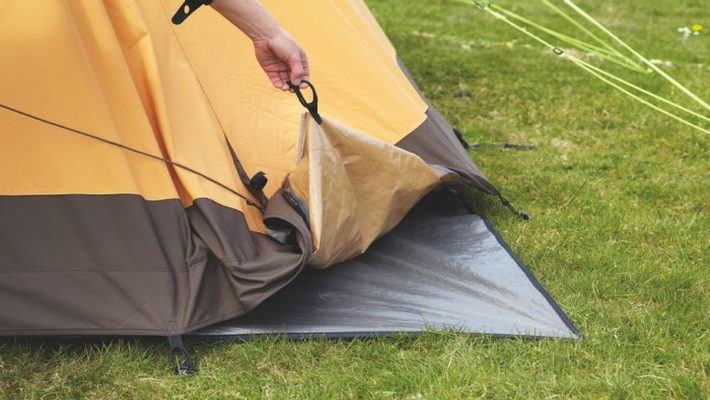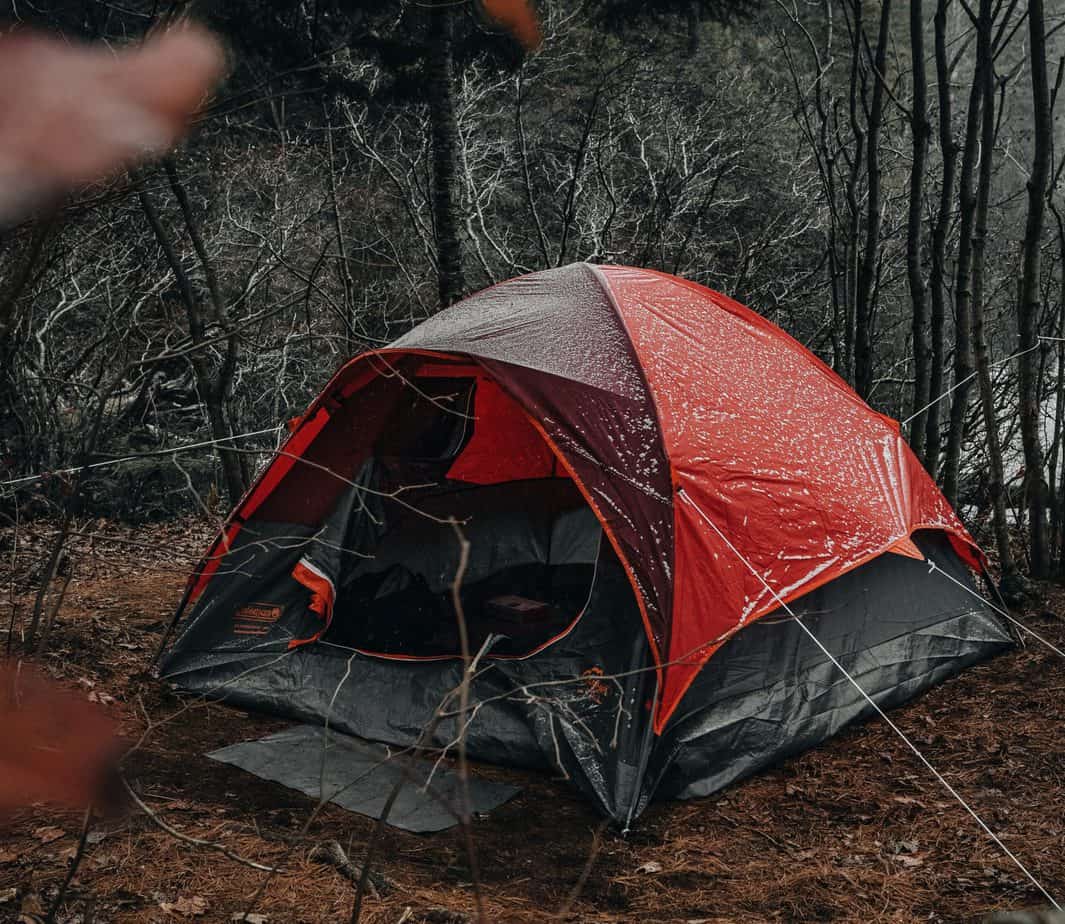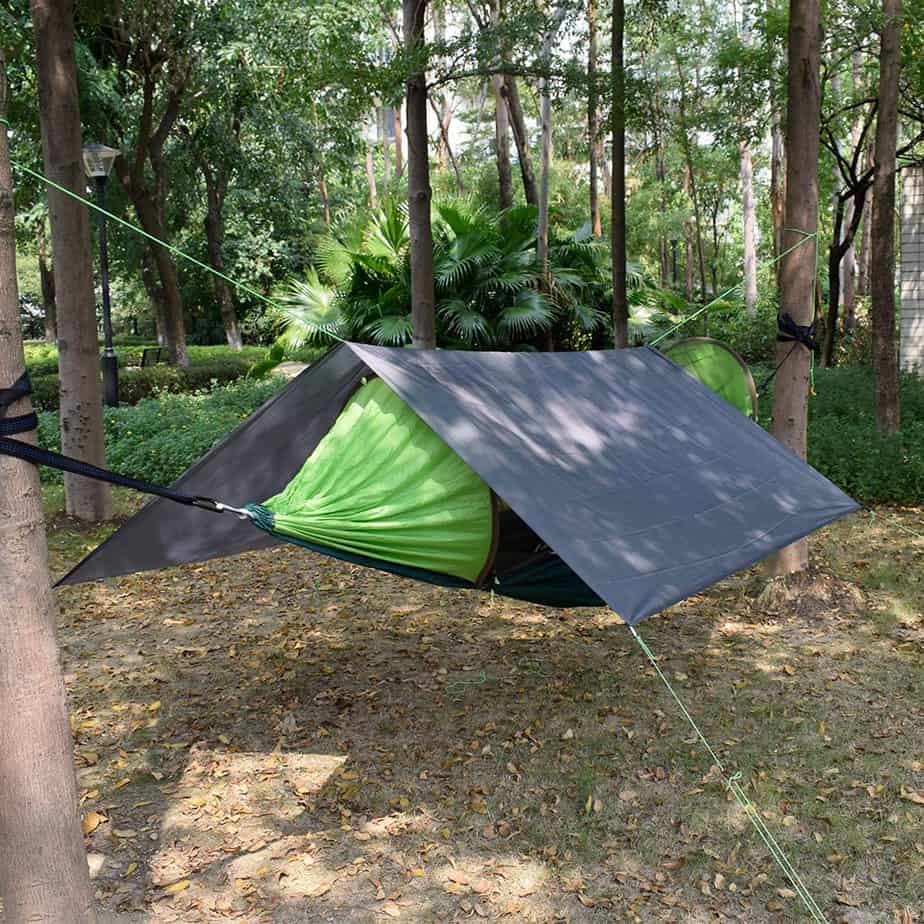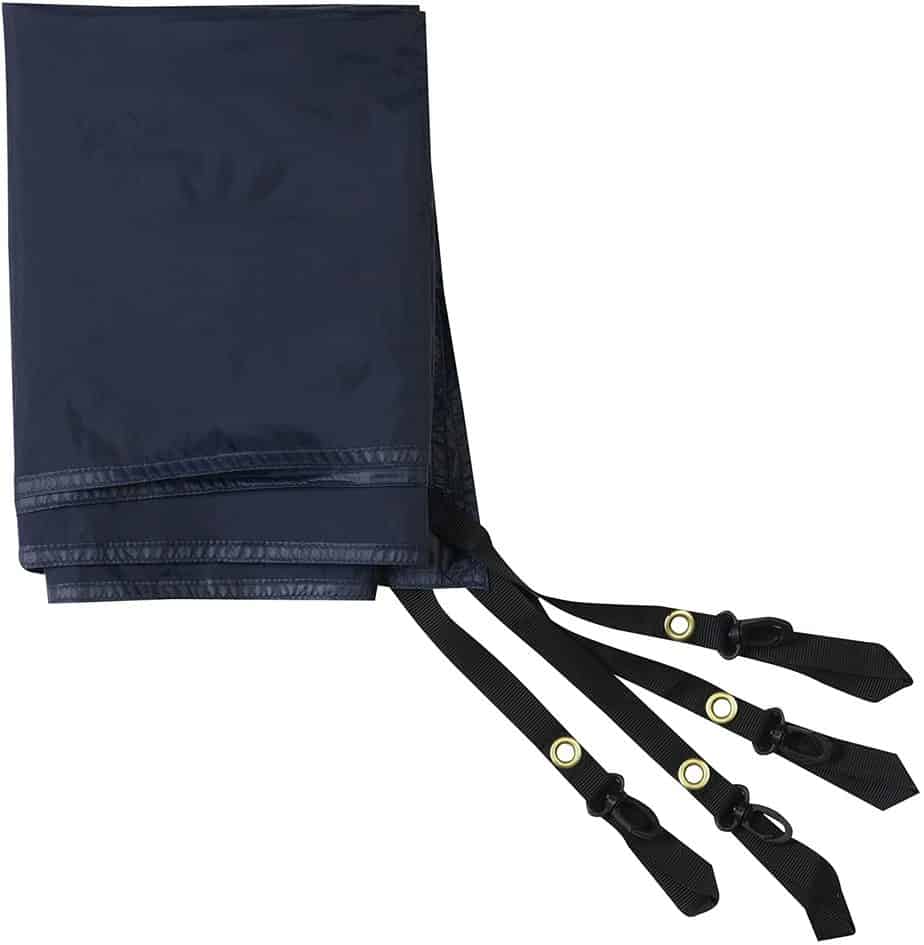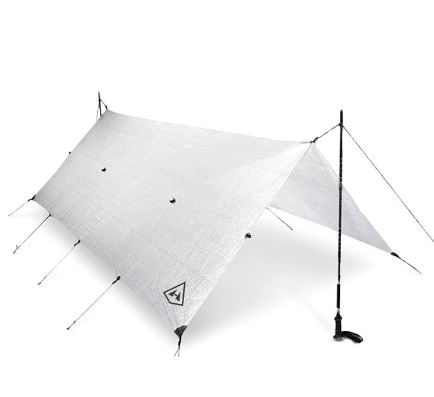When it comes to a camping trip, the most important factor to consider when deciding on your setup is safety.
There are a lot of different accessories, gear, and tools that you can use to increase the overall security and comfort of your tent or camping setup regardless of location.
Table of Contents
Main Difference Between Tent Footprint vs Tarp
The main difference between a tent footprint and a Tarp is:
- A tent footprint specifically protects the ends of the tent where it meets the ground, whereas and tarps can be used to protect the entire tent
- A tent tarp is generally less expensive compared to a specific tent footprint
- Tent tarps are generally easy to set up, whereas tent footprints have to be precisely planted
You might think that any old tarp works for tents. That's a mistake that I made. After trial and error I settled on this heavy duty tent. Waterproof, UV resistant, Rot Proof, Rip Proof, and Tear Proof.
Like with all things, there are several different components and tools that you can use to provide a more comfortable tent experience to your party of campers.
There are a lot of different variables and elements which can have a significant impact on the quality of your outdoor experience if you fail to set up your tent location correctly.
The good news is that you have the ability to control how safe and reliable your tent installation will be as long as you take the time to educate yourself on the proper techniques and equipment that you’ll need.
Just like a home, the two main important aspects of your camping setup involve your roofing and flooring materials.
Obviously, out in the wild (particularly for sleeping), there are a limited number of options available to you in terms of establishing a solid (and dry) roofing and flooring structure, however, the available options provide formidable options for you to choose from before you pitch your tent. All have a variety of pros and cons.
Those two options are tent footprints and tarps, while both of these tools provide different levels of protection and coverage, they are interchangeable and can be used in combination for extra comfort and security while out camping.
Depending on where you decide to set up camp, a tent footprint and a tarp may be required for maximum protection and support while out in the wild. To decide on which accessory you should use, you will need to consider your personal needs. These include things like the length of your trip, the location of your campsite, how large your tent area is, and much more.
All of these variables will play a key role in helping you figure out which setup will provide optimal coverage and functionality for you while exploring the good outdoors. If you’re someone interested in elevating your camping game and have been trying to figure out the difference between tent footprints and tarps, you’ve come to the right place.
In this guide, we’re going to go over all of the main differences between tarps and tent footprints in addition to how you will be able to select which one is right for your particular needs. To begin, let’s take a look at exactly what tent footprints and tarps are.
Tent Footprints & Tarps – What Are They?
Before we get into the intricate details about tent footprints and tarps, it’s important to describe exactly what they are so that you will be able to have a better understanding as to which one is right for your intended camping setup. In the following section, we’re going to take a look at exactly what the two tent accessories are and how they function to provide you with perfect all-around support while on your outdoor journey.
Tent Footprints
Tent footprints are large pieces of special materials that are placed on the ground or underneath your tent. They help protect the bottom of the tent from taking on unnecessary damage or wear due to coming in direct contact with the raw surface ground underneath.
Tents tend to be very vulnerable to damage largely due to the fact that the materials from which they are made only provide temporary protection for you against the elements. Tent footprints are optimal for those that are camping or setting up a tent on surfaces that are really abrasive like beaches, deserts, and rocky areas.
Tarps
Tarps, on the other hand, are pieces of extremely durable material which is placed on top and underneath your tent. Tarps provide a durable layer of protection for you and your tent against external elements which may come from above whether it be rain or something else. Tarps can also go underneath your tent for added protection against wear and general damage.
Both of these items pack a lot of versatile functionality besides strictly protecting your tent from damage. Now, let’s look at some of the main differences between tarps and tent footprints so that you can decide which option will be the best for your intended use.
The Main Differences Between Tent Footprints & Tarps
Deciding on whether or not you should install a tent footprint or tarp can be a difficult decision to make. Largely due to the fact that they share a lot of similarities, at the same time, they also share many differences which will be important for you to remember before making your final purchase decision.
In the following section, we’re going to explore some of the main differences between tent footprints and tarps so that you will be able to make an educated decision about which one is best for you. Make sure you read this entire section in full so that you can make sure you understand everything you need to know about these two pieces of camping infrastructure.
|
Tent Footprint |
Tarps |
|
|
The main difference between these two mainly lies in the intended use and amount of coverage that each option provides. They both are primarily designed to further increase and enhance the overall safety and comfort of your tent. Things such as size and height will play a very important role in the final decision that you make in terms of whether to use a tent footprint or a tarp.
Below, we’re going to list some of the core elements that will play a major role in helping you make your final decision.
Environment
The environment that you’re going to be setting up your tent in will impact whether or not you should use a tent footprint or tarp.
Environments that have rather rough surfaces like sand, rocks, or mud will require that you use some sort of floor protectant and covering to prevent injury and potential accidents from happening while on your trip. Both tarps and tent footprints can be used for protecting yourself against abrasive ground services and environments.
One thing to keep in mind is that every tarp and footprint will be made from an array of different materials. All of these material compositions come in varying levels of strength, which means that some materials will provide more protection when compared to others.
You should always consider the material fibers that your selected item is made from in direct comparison to the environment in which you’ll be staying. This will allow you to make an accurate decision about which option is right.
Weather
Weather can be unpredictable anywhere especially out in nature which is why you want to consider this before choosing which tool is best for you.
When it begins to rain on your campsite, not only will the moisture begin to affect the top of your tent, it will also collect around the bottom area of your tent. Because of this, you need to lay down water and weather-resistant padding which will provide some sort of solid foundation for you to walk on and carry out your various activities.
Tarps are a great option for protecting yourself against rain and extreme weather that is coming from above however tent footprints are best for reducing the amount of water build-up near the bottom of your tent. The last thing you want is for some bad weather to ruin your camping or outdoor exploration trip so be sure to keep this in mind when making your final purchase decision.
Temperature
Temperature also impacts you in several areas which you’ll need to cover to maintain a safe place for rest while out in nature.
Tarps can provide great coverage and protection for you against extreme heat from above while tent footprints will be able to help you maintain a solid barrier between the ground and your feet. Always remember to prioritize the management of your surroundings whenever camping so that you can choose equipment that will accent the experience.
Now that we’ve gone over some of the most important factors for you to consider when buying a protective build-out accessory for your tent, it’s time to take a more in-depth look at tent footprints and tarps so that you can see exactly why they are so important to the overall camping experience.
In-Depth Look: Tent Footprints Vs. Tarps
Every location will have its own unique characteristics and attributes which require you to adapt in order to maintain security and comfort inside and outside of your tent.
Both tent footprints and tarps give you the ability to configure your tent set up to the exact specifications that will be required to provide you with the experience you want.
To set up your tent right, you need to know all of the specific details as they relate to tent footprints and tarps so that you will be educated as to how each of them is applied in real-world situations and how to select which one is right for your intended use.
In the following section, we’re going to go into detail about all of the key benefits and attributes to both tarps and tent footprints so that you can have a clearer picture of how they will exactly benefit you while out in nature.
Tent Footprint Specifications
There are a lot of benefits to using a tent footprint mainly the added durability and damage-resistant that they provide. A lot of tents currently available on the market have floors made from a material called groundsheet which is not durable at all.
The material can easily be ripped or damaged by small variables in the environment such as loose tree branches, rocks, and more. By using a tent footprint, you will be able to reduce the overall impact that these various elements have on the quality of your tent.
They act as protectors for the entire lower side of your tent and can help extend the lifespan of your tent overall. This is great for those than camp on muddy and moist soil or camping in areas that are known to experience regular rains. Tent footprints also act as insulators helping to regulate a stable and normal temperature within the interior of your tent due to their ability to resist water retention.
You may be surprised to learn that there are actually several different types of tent footprints for you to choose from. Continue reading below to gain more knowledge about the various tent footprint variants and models.
Solid Footprints
Solid tent footprints oftentimes mimic tarps due to their solid construction and weather-resistant capabilities. These style footprints also tend to be a lot more affordable than other options on the market and provide a very formidable layer of protection for you and your tent setup.
They are also really easy to clean which makes them an optimal choice for many campers who want convenience and protection.
Mesh Footprints
Mesh footprints are made from a porous material that allows you to add an extra layer of protection to your tent without impacting the overall experience.
One thing to keep in mind about these types of footprints is that they are not as resistant to water and moisture retention as their more durable solid counterparts are so you may want to choose another option if you plan on setting up your tent in an area with lots of rain or wet ground.
Tarp Specifications
While tarps are very similar to tent footprints, they offer more versatility in terms of the applications in which they can be applied. With the right tarp, you can use it as a roof covering, heat reflector, or even a pole which adds a lot more value to your initial purchase when compared to tent footprints and their primary function of providing floor coverage.
Using a tarp as protection for the bottom portion of your tent is a really good idea because it will add an extra layer of flood protection to your entire setup.
They also work great for resisting damaged that is commonly caused by rocks and other debris you will find while out in nature. If something happens to your main tent unit while out in the wild, you can also use your tarp as a makeshift shelter by simply hoisting it up on both ends with a pole.
You can also use them to extend the overall coverage of your tent roofing or you could opt to use them as protection for your other items such as accessories.
If you plan on cooking, you can use a tarp as a great heat insulator and conductor above your cooking setup to keep heat from the inside in and heat from the outside out. Tarps also tend to be much easier to carry around due to their lightweight construction. They also are great for blocking out UV radiation because their thick layers block the sun from being able to penetrate it.
Now that we’ve covered some of the core details about each tent protection tool, let’s take a look at how you can decide when to use them and which one is best for your intended setup.
When to Use Them? Tent Footprints Vs. Tarps
Knowing a little bit more about the differences, similarities, and capabilities of both tent footprints and tarps, you’re probably asking yourself which one is right for you. To help you make the best decision, this entire section is dedicated to helping you determine which protection type you will use.
Tent footprints are generally best in situations that involve a lot of water and wet ground conditions. They are very thick and heavy which is great for keeping excess water or moisture from reaching the inside of your tent. If you know that you’re going to be setting up your tent in an area that has a rather rough ground surface, you will want to use a footprint to protect your tent from becoming damaged or torn while in use.
Tarps, on the other hand, are mainly reserved for protecting your tent and self from excessive heat, rain, and other external conditions. If you’re someone who needs versatility and protection, a tarp may be the best option for you to choose largely due to how easy they are to carry and the wide range of different applications in which you can use them.
The best way to decide on which tent add-on you should use is by analyzing the environment in which you’ll be staying. By identifying all of the core threats that will be on your path, you will be able to wisely choose which unit of protection and coverage will be best for you.
Now, it’s time to answer some of the most commonly asked questions that people have in regards to tent footprints and tarps.
FAQs
We’ve covered a lot of information so far in relation to tarps and tent footprints and how each of them provides its own unique benefits to those using them. This section is going to be dedicated to answering some of the most commonly asked questions that people have when it comes to both of these tent accessories so that you will be able to make your final purchase decision with confidence.
Question: Can I use a tent footprint or tarp with any tent?
Answer: Yes, tarps and tent footprints do not have any limitations in terms of what tents they can be used with.
Question: How do I set it up?
Answer: The setup process will vary depending on which apparatus you use and how compatible it is with your tent. Always read the instruction manual that comes with your tarp or tent footprint to ensure that you’re carrying out the steps correctly.
Question: What if it’s too big for my tent?
Answer: If your selected covering is too big for your tent, just find a way to tailor it so that it will fit correctly. The only issue you may run into is condensation forming on the outside of your tent in humid conditions. As long as you make sure it’s securely fastened to your tent, you should have no problems.
Our Decision
Now is the part that you’ve been waiting for, it’s time to tell you what option we think provides the most protection and comfort for campers of all types while out in the wild. When it comes to which one is better between tarps and tent footprints, the choice is really all up to you.
Some people prefer the heavyweight protection of a tent footprint while others like the versatility and multi-purpose use of tarps a lot more. The ultimate deciding factor will come down to the type of environment that you’re camping in and all of the surrounding elements which may have an impact on your experience.
As long as you take these crucial elements into consideration, either one of these options will work just fine for providing you with the protection you need while out camping.
Top Tent Tarp & Tent Footprint Recommendations
Now that we’ve covered all of the most important variables and factors you need to consider, it’s time to list our top recommendations for tarps and tent footprints currently on the market. Keep in mind that all of these suggestions are made using different materials and overall design rules so you’ll want to keep your personal needs at the forefront before making a final purchase decision.
#1 Geertop 1-4 Person Ultralight Waterproof Tent Footprint
The Geertop 1-4 Person Ultralight Waterproof Tent Footprint is made out of premium quality 20D nylon material which is very durable and resistant to damage and scratches. The footprint is also packing a unique design element that uses double-size silicone to add an extra layer of protection against water accumulation and moisture.
The unit is very lightweight and easy to carry around which makes it great for those who need versatility. This footprint comes in a variety of different sizes all designed to provide maximum protection for your tent under all sorts of conditions.
All you have to do is unroll it and place it around your tent on the ground in order to begin experiencing the level of comfort and protection that it provides.
A good camping tarp is essential to lounge in comfort. Footprint with 4 metal ring holes for extensive usage for setting up, shelter, rain cover or dampproof mat for your camping tent. The footprint can be packed into a compact size, very small and light; comes with a drawstring pouch provides convenience for travels.
#2 Kelty Salida 2 Tent Footprint
The Kelty Salida 2 Tent Footprint is made out of a unique material known as 68D polyester which provides a durable layer of protection for your tent against external elements. Its design is rugged yet lightweight which makes it easy to carry around and transport while on your journey. The footprint only comes in one size which is 7ft long and 3in wide which should be suitable to fit most tent options out on the market right now.
The footprint also uses 1800mm DWR which adds a tight a nearly impenetrable layer of protection for your tent against heavy water or muddy ground. It also comes with fastening attachments which make it easier for you to secure the footprint to your tent and primary resting location.
Kelty footprints extend the life of your tent’s floor by protecting it from rough or abrasive surfaces. Kelty footprints are fitted (slightly smaller) to match the shape of your tent floor.
#3 Super Heavy Duty 16 Mil Brown Poly Tarp Cover
The Super Heavy Duty 16 Mil Brown Poly Tarps Cover is made out of very durable materials which provide weatherproof and waterproof protection for your tent in any situation. The fabric on the tarp measures to be about 16mm thick which is more than enough to shield you from the external elements in any environment.
This tarp is outfitted with UV protection which is great if you plan on camping in a really sunny or hot area without being exposed to the sun.
Its polyethylene material is long-lasting with wear and tear and does not wear out like many standard plastic tarps on the market making (generic blue tarp, Tyvek tark, canvas tarps, etc…) it a premium selection. You can also use it to cover your car or other equipment and accessories that you may have when not out in nature making it very versatile.
You might think that any old tarp works for tents. That's a mistake that I made. After trial and error I settled on this heavy duty tent. Waterproof, UV resistant, Rot Proof, Rip Proof, and Tear Proof.
Other Tarp and Footprint Options
These are also some other tarps to consider for various camping gear use cases:
- Hyperlite Mountain Gear Flat Tarp: Dyneema Cuben Fiber tarp, ideal for use as a shelter OVER the tent like a rain fly (often more effective than a footprint)
- Noah’s Tarp
- Black Diamond Mega Tarp Pyramid Shelter
- Outad Waterproof Camping Tarp (better than water-resistant material)
- Gossamer Gear Twinn Tarp
The ultimate minimalist, ultralight tarp shelter for backpacking, our Flat Tarp is engineered to be precisely what passionate adventurers need and nothing more.
Whether you’re chillin’ between tube runs or mixing up killer camp cocktails, Noah’s Tarp 9 is an essential piece of your adventure kit. This simple shelter stores in a convenient roll-top carry bag to go with you on every kind of adventure, and comes in sizes to throw shade for groups of 1–20. Put it up over your dining area, picnic spread, hammock, or provide shade for the doggos.
Whether you are backpacking through the jungle, working in the backyard, gathering at an outdoor festival, relaxing in a hammock in the woods, hiking in the mountains, or spending a relaxing afternoon in the local park, OUTAD ensures you stay safe, dry and protected.
Conclusion: Tent Tarp or Footprint?
Now, you know everything that there is to know about tent footprints and tarps and how they both provide different benefits of tarp camping based upon your camping configuration.
By using all of the tips and information we’ve included in this guide, you will be able to confidently make the right decision on which system you want to use to protect your tent the next time you’re out in nature.
As long as you consider your personal needs on an individual basis and take your time to read the features of each option you come across, you’ll be able to make the right choice in no time, whether you are backpacking or planning for a group of hikers. Start protecting your tent and camping experience by using either a tent footprint or tarp the next time you’re out!
Further Reading on Tents and Tarps
- Sea to Summit Escapist Tarp Review (Tarp Shelter)
- Best Hammock Tarps for Shelter [Buying Guide]
- Roofnest Sparrow Review

The All-Outdoors Guide team is comprised of enthusiastic experts that enjoy helping others that aspire to be better at outdoor fun. Part of that is making sure you have the right gear and information when it’s time to go out and have fun. Some of our team have accomplished amazing feats like climbing 6000 feet to the top of mountains, others have explored every dirt trail they could find and we even have some people that have backpacked solo on various continents. No matter what our readers want to learn and do, our team is here to help them accomplish those goals.






